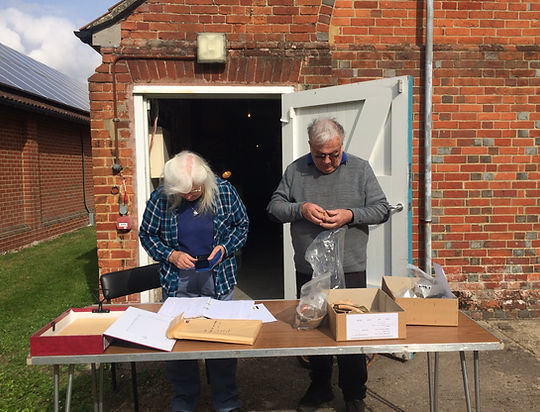Anglo-Saxon Romsey
The Evidence in the Landscape
Excavations in Romsey
Numerous excavations in Romsey have uncovered Anglo-Saxon material, but very little of the work has been published. The finds from the excavations, along with plans and field notes, are stored at Chilcomb House near Winchester under the care of the Hampshire Cultural Trust. Members of the project group with a background in archaeology have examined and photographed the material from several of the sites. Excavating the archives has provided evidence that has been valuable for our research into the Saxon iron smelting industry and the Fishlake.


Mary Harris and Stephen Cooper examining excavation finds and documents at Chilcomb House.
Photos by Karen Anderson
In the early 1990s, Ian Scott reviewed the archive on the unpublished excavations. His report on The Evidence from Excavation for Late Iron Age, Roman and Saxon Occupation in Romsey was never published and is not available online. There is a paper copy in Chilcomb House dated July 1993. The drawings of the finds, plans and sections in this copy are incomplete.

Scott’s unpublished map of excavations in Romsey.

Scott’s unpublished map showing central Romsey and the two branches of the Fishlake.
As part of the local history society project, the excavation evidence on Saxon Romsey was collected together from published and unpublished sources. A document was compiled giving a summary of each excavation along with any plans and section drawings that were available. Having carried out this exercise, it has been a bit of a surprise to examine the original field notes and finds stored at Chilcomb House. There is far more evidence on the period than we were expecting to find. We intend to examine and photograph more of the archived material.
Read Romsey Excavations
The Journal for Medieval Archaeology summarises excavations carried out each year in its News and Notes section. A compilation of excavations in the lower Test valley is available here.

A short video is available on YouTube describing the excavation of an extension to Bradbeers department store on Bell Street. In the main photo the presenter, archaeologist Andy Russell, is pointing out a large piece of iron slag found on the site.